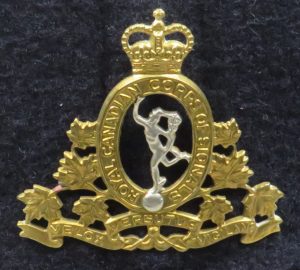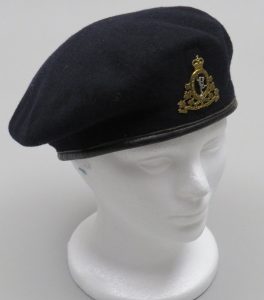
(3/25)
In honour of the Diefenbunker’s 25th anniversary, we continue to highlight 25 artifacts from within our collections. This week, we are featuring a military beret from the Royal Canadian Corps of Signals (RCCS).
Originally established as a militia support unit in 1903, the RCCS became part of the permanent Canadian Army following the end of World War I and was responsible for land communication and signalling. When the Royal Canadian Navy, Army, and Air Force were unified in 1968 to form the Canadian Armed Forces, the RCCS was amalgamated with the other communications units into the Communications and Electronics Branch. The RCCS also assisted in operating CFS Carp during the site’s thirty-three years of continuous operation until 1994.

Blue Beret, Diefenbunker Museum: 2003.001.001
This military beret is a soft, round, flat-crowned cap that is dark blue and likely made of a wool felt fabric while the rim lining is constructed with leather. The beret was made for use by the Canadian military, as indicated by the yellow badge that is located in the centre of the cap. This metal badge is the insignia of the RCCS. The badge is constructed with a hollow oval in the centre that has a figure at its core. This figure is the Roman god Mercury who was the god of translation, interpretation, and communication. Around the edge of the oval is the text “Royal Canadian Corps of Signals,” and at the top of the oval is a Tudor Crown. Framing the sides of the oval are a total of eight maple leaves, four on each side. At the bottom is a ribbon with the motto “Velox, Versutus, Vigilans,” which is Latin for “Swift, Skilled, Alert.”

Blue Beret, Diefenbunker Museum: 2003.001.001
This blue beret was made by the Dorothea Knitting Mills of Toronto, better known to the public as Parkhurst Knitwear. Originally founded in 1926 by Louis Borsook, this company specialized in knitting berets, both for sale to the general public and for use by the Canadian military. The company still operates today and they have branched out into producing other clothing articles and textiles.
Stay tuned as we continue to celebrate our 25th anniversary by uncovering stories from our museum’s collections.
